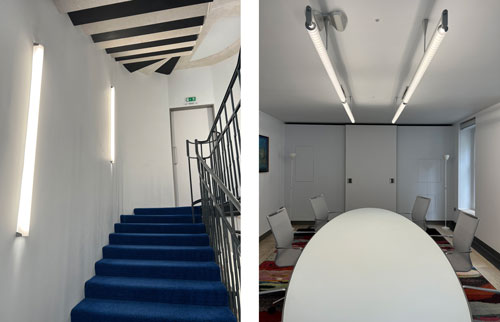Reuse of lights at London office leads to 67% cut in costs

The upgrade and reuse of luminaires combined with a reprogrammed control system has led to a 67 per cent reduction in running costs at a London office.
WSP Specialist Lighting team provided consulting services and project management for a five-storey office in the City of Westminster, retrofitting the existing lighting with an upgraded LED lighting solution.
WSP developed a strategy to replace all fluorescent, metal halide and halogen lamps with new LEDs.
The upgrade offers power savings for the Client of approximately 40 per cent, this figure is based on a comparison of the existing luminaire wattage, against the new LED sources. High quality LEDs have up to five times the operational life of traditional light sources, reducing the frequency and time required for maintenance and replacement.
The lighting control system was recommissioned to control the new LED luminaires, increasing the LED lifetime by offering the possibility of dimming and automatic on/off triggers, using presence detectors, when spaces are not in use, so that no unnecessary power is wasted. The control system was not previously functional and therefore the previous system was running at full power when switched on.
Circular economy principles and sustainability were also considered when selecting the manufacturer to perform the LED replacements. ‘This was a difficult task as most of the light fixtures in the office building were bespoke and required specialist consideration,’ said Sacha Abizadeh, head of architectural lighting at WSP.
The luminaire optics were upgraded in line with the new technology to produce a visually pleasing and technical scheme. WSP lighting team sourced a UK based manufacturer, this decreased the project complexity and embodied carbon due to the proximity to site.
The existing luminaires were sent to a local workshop for refurbishment. These were upgraded and reused with new LEDs, drivers, and a new warranty.
All the existing light fixture housings were reused and adapted for LED lamp usage. Lighting mock-ups and final tests were undertaken on site with client approval.
The use of LED technology and the reprogramming of the lighting control system, has provided the occupants and maintenance managers a reduction of operating and maintenance costs while, considering how to sustainably upgrade the existing design. Typically, the return on investment will be achieved within two years.
In summary following the replacement of traditional light sources with LED technologies, upgrades to the lighting control system and minor electronic tweaks achieved; upgrade offer of 40 per cent power savings (when directly comparing the existing wattage versus the new installed LED components) and a 67 per cent saving on the annual running costs.
• Diary date: Circular Lighting Live 2024, Recolight’s flagship conference and exhibition, takes place on Wednesday 9 October 2024 at the Royal College of Physicians in London. Free to specifiers, Circular Lighting Live 2024 will feature leading experts, specifiers and policy makers who will share their insights into forthcoming standards and legislation, emerging technologies and new business models. More info: www.circularlighting.live


